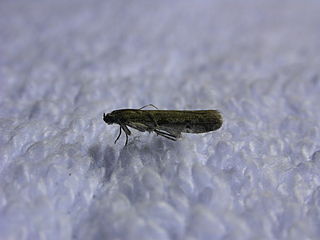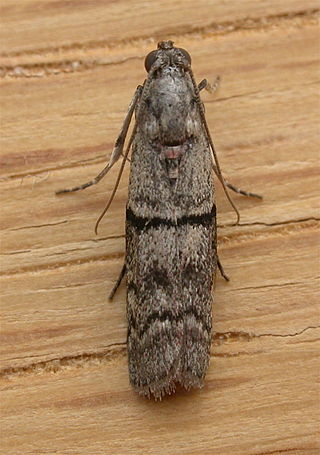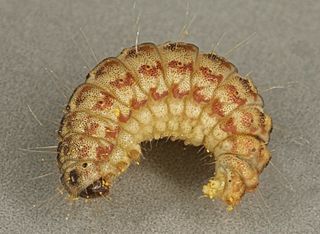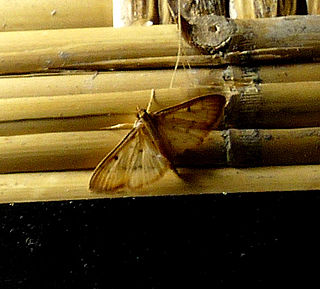
The Pyraloidea are a moth superfamily containing about 16,000 described species worldwide, and probably at least as many more remain to be described. They are generally fairly small moths, and as such, they have been traditionally associated with the paraphyletic Microlepidoptera.

Oncocera semirubella is a small moth of the family Pyralidae. It is found in European regions, including the British Isles, and East Asia.

Udea ferrugalis, the rusty dot pearl, is a moth of the family Crambidae. The species was first described by Jacob Hübner in 1796.

Parapoynx fluctuosalis or Fluctuating China-mark or Waved China-mark, is a moth of the family Crambidae. It is a widespread species, known from Africa, India, Sri Lanka, China, Japan, Malaysia, Taiwan, Guam, Hawaii, Fiji, Australia and the Galápagos Islands. It is also an introduced species in Europe, where it has been recorded from Great Britain, the Iberian Peninsula and Sardinia.

Pyralis regalis is a species of snout moth. It is found from most of Europe east to Asia, including China, Cambodia, Myanmar, India, Russia, Korea, Japan and Taiwan.

Phycitodes reliquella is a moth of the family Pyralidae described by Harrison Gray Dyar Jr. in 1904. It is known from North America where it is widely distributed in the east, including Alabama, Arkansas, Connecticut, the District of Columbia, Florida, Georgia, Illinois, Louisiana, Massachusetts, Maryland, Maine, North Carolina, New Hampshire, New Jersey, New York, Ohio, Oklahoma, Pennsylvania, South Carolina, Virginia and Ontario.

The Phycitini are a tribe of moths of the family Pyralidae.

Phycitodes is a genus of snout moths described by George Hampson in 1917.

Phycitodes albatella is a species of snout moth. It is found in most of Europe, Uzbekistan and North America.

Phycitodes binaevella is a species of snout moth described by Jacob Hübner in 1813. It is found in most of Europe, Asia Minor, Lebanon and the Palestinian Territories.
Phycitodes inquinatella is a species of snout moth. It is found in most of Europe, the Canary Islands, Turkey and the Palestinian Territories.

Phycitodes lacteella is a species of snout moth first described by Walter Rothschild in 1915. It is found in most of Europe, Algeria, Morocco and Turkey.

Phycitodes maritima is a species of snout moth. It is found in most of Europe.

Phycitodes saxicola, the small clouded knot-horn, is a species of snout moth described by Vaughan in 1870. It is found in most of Europe, as well as Iran, Morocco and the Canary Islands.
Phycitodes eliseannae is a species of snout moth. It is found in France and Spain.
Phycitodes gallicella is a species of snout moth which is endemic to France.

Laodamia faecella is a species of snout moth. It is found from most of Europe to Japan.

Herpetogramma basalis is a species of moth in the family Crambidae. It is found on the Canary Islands and in Japan, China, Australia, Sri Lanka, India, Indonesia, La Réunion, South Africa, and Mali.

Loxostege turbidalis is a species of moth in the family Crambidae. It was described by Treitschke in 1829. It is found in most of Europe, except Ireland, Great Britain, Norway, the Benelux and the Iberian Peninsula. It has also been recorded from Russia, Turkey, China and Japan.















